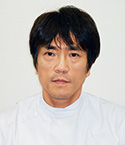Department of Cardiovascular Medicine
Overview of the department

Chairman
Prof. Tada Hiroshi
Consultation system/therapeutic strategies
Heart disease-related emergencies are managed based on a 24-hour system by a team consisting of more than 10 specialized staff members. In particular, coronary catheterization, aortic balloon pumping, cardiopulmonary bypass, such as percutaneous cardiopulmonary assistance and continuous hemofiltration, and high-level critical care with pacemaker/defibrillator implantations are aggressively performed to treat patients with acute myocardial infarctions, severe heart failure, and fatal arrhythmias. We are making efforts to provide a safe, minimally invasive treatment, targeting a high-level medical practice that is comfortable for the patients.
Field of expertise
1) Drug therapy/catheterization for angina pectoris/myocardial infarctions
2) Catheterization for peripheral arterial disease (lower-limb arteries)
3) Drug therapy/catheter ablation therapy/device treatment (pacemaker, implantable cardioverter-defibrillator [ICD]for arrhythmias,cardiac resynchroni
4) Drug/non-drug therapy (including cardiac resynchronization therapy) for severe chronic heart failure, treatment for hypertension, and prevention of organ disorder deterioration
5) Diagnosis/treatment of cardiomyopathy (hypertrophic/dilated cardiomyopathy)
6) Optimal drug therapy for metabolic syndrome
7) Cardiovascular imaging(PET,SPECT,MOCT,MRI,TTE,TEE)
Advanced medical practice
Cardiovascular catheterization
Percutaneous coronary angioplasty with a drug-eluting stent, after which the incidence of restenosis is markedly low, and rotablator therapy for markedly calcified lesions are performed in accordance with the individual conditions.
Peripheral arterial catheterization
Intravascular treatment of the iliac/lower-limb arteries for obstructive arteriosclerosis of the lower limbs, as well as renal artery dilatation for arterial stenosis-related refractory hypertension, heart failure, and renal failure, are performed.
Cardiac resynchronization therapy
Drug-resistant, refractory heart failure is treated using biventricular pacemakers.
ICD Implantation
To prevent sudden cardiac death related to fatal arrhythmias such as ventricular tachycardia/fibrillation, this procedure is performed.
Radiofrequency catheter ablation
This is radical therapy for tachyarrhythmias, such as atrial fibrillation. It is aggressively conducted in indicated patients. Cryoballoon ablation is also available for the treatment of atrial fibrillation.
Symptoms/diseases treated in our department
Persons with the following symptoms should consult the Department of Cardiovascular Medicine:
○Anginal pain of the chest/back that develops suddenly
○Shortness of breath during exercise
○Dyspnea-related inability to sleep in a supine position, edema of the hands/legs
○Palpitation/arrhythmias
○Becoming pale with a consciousness disorder
○Calf pain on walking
In addition, please consult the Department of Cardiovascular Medicine when a health checkup reveals a high blood pressure, abnormal electrocardiographic findings, or an increase in the heart size on radiography.
Primary examinations and explanations
In our hospital, resting electrocardiography, exercise electrocardiography, 24-hour Holter’s electrocardiography, Signal-averaged electrocardiogram, plethysmography, echocardiography, carotid ultrasonography, cardiac CT/MRI/PET, and nuclear medicine examination of the heart are performed in accordance with the conditions for the early detection/treatment of cardiovascular diseases and a morbid-state assessment.
 University of Fukui Hospital
University of Fukui Hospital University of Fukui Hospital
University of Fukui Hospital +81-776-61-311
+81-776-61-311 Access
Access